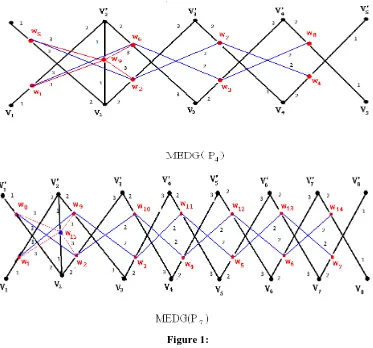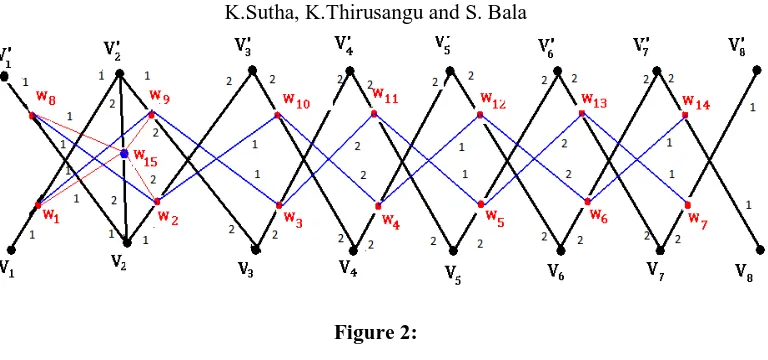Vol. 8, No. 2, 2014, 169-174
ISSN: 2279-087X (P), 2279-0888(online) Published on 17 December 2014
www.researchmathsci.org
169
Some Graph Labelings on Middle Graph of Extended
Duplicate Graph of a Path
K. Sutha1, K.Thirusangu2 and S. Bala3
Department of Mathematics, S. I. V. E. T. College, Gowrivakkam Chennai – 600 073, India.
E-mail: sutharavindran@yahoo.com; kthirusangu@gmail.com; balasankarasubbu@yahoo.com
Received 2 November 2014; accepted 21 November 2014
Abstract. A graph labeling is an assignment of integers to the vertices, or edges, or both subject to certain conditions. In this paper, we prove the existence of Z3- magic, and Z4- bi magic labelings for the middle graph of extended duplicate graph of a path by presenting algorithms.
Keywords: Graph labeling, Middle graph, Extended duplicate graph
AMS Mathematics Subject Classification (2010): 05C78
1. Introduction
The concept of graph labeling was introduced by Rosa in 1967. A graph labeling is an assignment of integers to the vertices or edges or both subject to certain conditions. Labeled graphs serve as useful models for broad range of applications such as coding theory, X-ray, crystallography, radar, astronomy, circuit design, communication networks and data base management and models for constraint programming over finite domain. Hence in the intervening years various labeling of graphs such as graceful labeling, harmonious labeling, magic, anti-magic labeling, bi-magic labeling, prime labeling, cordial labeling, total cordial labeling, k-graceful labeling and odd graceful labeling etc., have been studied in over 1100 papers .The concept of extended duplicate graph was introduced by Thirusangu, et al. in [9] and they proved EDG(Pm) is cordial.
170 2. Preliminaries
Let G = G(V,E) be a finite, simple and undirected graph with p vertices and q edges. By a labeling we mean a one-to-one mapping that carries a set of graph elements onto a set of numbers called labels(usually the set of integers). In this paper we deal with the labeling with domain either the set of all vertices or the set of all edges or the set of all vertices and edges. We call these labelings as the vertex labeling or the edge labeling or the total labeling respectively.
Definition 2.1. Let G(V,E) be a simple graph. A Duplicate graph of G is DG=(V1,E1) where the vertex set V1 = VV' and VV'=φand f: V→V' is bijective(for v V, we write f(v) = v' for convenience) and the edge set E1 of DG is defined as follows: The edge ab is in E if and only if both ab' and a'b are edges in E1. Clearly duplicate graph of a path is disconnected.
Definition 2.2. Let DG=(V1,E1)be a duplicate graph of a path G(V,E). Add an edge between any one vertex from V to any other vertex in V ', except the terminal vertices of V and V'. For convenience let us take v2 V and v2' V' and thus the edge ( v2 v2') is formed. This graph is called the Extended Duplicate of the path Pm and it is denoted by EDG(Pm) where ‘m’ represents the length of the path Pm .
Definition 2.3. A graph G(V,E) is said to admit Z3 -magic labeling if there exists a function f from E on to the set {1,2} such that the induced map f* on V defined by f*(vi)=∑ f(e)(mod 3) = k, a constant where e=(vivj) E.
Definition 2.4. A graph G(V,E) is said to admit Z4 -bi -magic labeling if there exists a function f from E on to the set {1,2,3} such that the induced map f* on V defined by f*(vi)=∑ f(e)(mod4)=k1 or k2, a constant where e=(vivj) E.
3. Main result
In this paper, we prove the existence of Z3 magic, and Z4-bi-magic for the middle graph of extended duplicate graph of a path by presenting algorithm.
Definition 3.1 : The middle graph of G(V,E) ,is defined with the vertex V(G) U E(G) where two vertices are adjacent iff they are either adjacent edges of G or one is a vertex and the other is an edge incident with it and it is denoted by M(G)
Definition 3.2 : The structure of middle graph of extended duplicate graph is defined as follows : Let EDG(Pm) be a graph with 2m+2 vertices {v1,v2…… vm+1,v1’,v2’…..v’m+1} and 2m+1 edges where ‘m’ represents the length of the path Pm. The middle graph of EDG(Pm) is obtained by introducing a new vertex wi on each edge as follows;
vivi+1’ wi ; 1 < i < m vivi-1’ wi+m-1 ; 2 < i < m+1 v2v2’ w2m+1
Thus MEDG(Pm), the middle graph of EDG(Pm) is a (V,E) graph where
171
Thus MEDG(Pm) has 4m+3 vertices and 6m+4 edges. Algorithm 3.1
procedure Z4 – bi-magic labeling of MEDG(Pm) Input : MEDG (Pm)
v1w1, v1’wm+1,v2w2m+1,v2’w2m+1,vm+1w2m,vm+1’wm 1 v2wm+1,v2’w1 2
w1wm+2,w2wm+1 3 for i=2 to m do
{
viwi,vi’wi+m 2 }
end for
for i=2 to m-1 do
{ wiwi+m 2
}
end for
for i=m+2 to 2m-1 do {
wiwi-m+1 2 }
end for
for i=3 to m do {
viwi+m-1,vi’wi-1 3 }
end for
for i=1,2,m+1,m+2 {
wiw2m+1 3 }
end for
output: Labeled MEDG (Pm) Algorithm 3.2:
procedure Z3- magic labeling for MEDG(Pm) Input : MEDG (Pm) where m 1(mod 2) // assignment of labels to the edges
v1w1,v2w2,v2wm+1,v2’w1,v1’wm+1,v2’wm+2,w1wm+2,w1w2m+1,w2wm+1,
vm+1w2m,vm+1’wm,wm+1w2m+1 1 v2w2m+1,v2’w2m+1,w2w2m+1,wm+2w2m+1 2
For i= 2 to m-1 and i 0(mod 2) do {
wi wi+m+1 1 }
end for
172 {
wiwi-m+1 1 }
end for
for i = 3 to m do {
viwi , viwi+m-1,vi’wi-1,vi’wi+m 2 }
end for
for i = 3 to m-1, i 1(mod 2) do {
wiwi+m+1 2 }
end for
for i=m+2 to 2m-1 and i 0(mod 2) do {
wiwi-m+1 2 }
end for
output : Labeled MEDG(Pm)
Theorem 3.1. The middle graph of EDG(Pm) is Z4 bi-magic.
Proof: From the structure of MEDG(Pm), it is clear that MEDG(Pm) has 4m + 3 vertices and 6m+4 edges. Denote the vertex set and edge set of MEDG(Pm) as given in the definition 3.2.
To prove MEDG(Pm) is Z4 bi-magic, we have to show that there exists a function f from E on to the set {1,2,3} such that the induced map f* : V {0, 1, 2, 3} defined by f*(v)=[ { ∑ f(uv)}(mod 4) /u N(v) ] = k1 or k2 , constants.
Using algorithm 3.1, the edges are labeled. Vertex labels are obtained as follows:
For 1 ≤ i ≤ m + 1 and 1 ≤ k ≤ 2m + 1
f * ( vi ) = {∑ f(vi wj )} (mod 4)= 1 f * ( vi ‘ ) = {∑f( vi’ wj ) }(mod 4)= 1.
f * ( wk )= ∑{f (wk vj) + f( wk vj’) + f (wk wj )} (mod 4)
=1, if 1 k 2m 2, otherwise
Thus all the weights of the vertices are either 1 or 2. Therefore MEDG(Pm) admits Z4 bi- magic labeling.
173 Figure 1:
Theorem 3.2. The middle graph of EDG(Pm) , m 1 (mod 2) is Z3-magic.
Proof: From the construction of MEDG(Pm), we have MEDG(Pm) has 4m + 3 vertices and 6m+4 edges. Denote the vertex set and edge set of MEDG(Pm) as given in the definition 3.2.
To prove MEDG(Pm), m 1 (mod 2) is Z3-magic, we have to show that there
exists a function f from E on to the set {1,2} such that the induced map f* : 0, 1, 2 defined by f*(v)=[{ ∑ f(uv) }(mod 3)/ u N(v) ] = k, a constant.
Using algorithm 3.2, the edges are labeled. Vertex labels are obtained as follows. For 1 ≤ i ≤ m + 1 and 1 ≤ k ≤ 2m + 1
f * ( vi ) = {∑ f(vi wk )} (mod 3)= 1 f * ( vi ‘ ) = {∑f( vi’ w k) }(mod 3)= 1
f * ( wk )= ∑{f (wk vj) + f( wk vj’) + f (wk wj )} (mod 3)= 1
Since all the vertices receive the same label ‘1’ , MEDG(Pm), m 1 (mod 2) admits Z3- magic labeling..
174 Figure 2:
4. Conclusion
In this paper, we have presented the algorithms and proved the existence of Z3- magic and Z4- bi magic labeling for the middle graph of extended duplicate graph of a path Pm. .
REFERENCES
1. J. Akiyama, T. Hamada and I. Yoshimura, On characterization of middle graphs, TRU Math., 11 (1975) 35-39.
2. E Bala and K.Thirusangu, On Bi-Magic labeling of 4-regular graphs, Indian Journal of Science and Technology, 4(4) (2011) 414-416.
3. E Bala and K. Thirusangu, E-Cordial and Z3 – magic labeling in extended triplicate graph of a path, General Mathematics Notes, 5(2) (2011) 8-23.
4. J.A.Bondy and U.S.R.Murthy, Graph Theory with Applications, 1976.
5. M. Borowiecki, A characterization of middle graphs and a matroid associated with middle graphs of hyper graphs, Fund. Math., CXVII (1983) 1-4.
6. J.A.Gallian, A dynamic survey of graph labeling, The Electronic Journal of Combinatories, 16 (2013) # DS6.
7. S.Paul, M.Pal and A.Pal,L(2,1)-labeling of circular-arc graph, Annals of Pure and Applied Mathematics, 5(2) (2014) 208-219
8. M.Skowronska, Maciej and M.Syslo, An algorithm to recognize a middle graph, Discrete Applied Mathematics, 7 (1984) 201-208.
9. P.P.Ulaganathan, K.Thirusangu and B.Selvam, Edge magic total labeling in extended duplicate graph of path, International Journal of Applied Engineering Research,
6(10) (2011) 1211-1217.
10. S.K.Vaidya and N.B.Vyas, Anti-magic labeling of some path and cycle releated graphs, Annals of Pure and Applied Mathematics, 3(2) (2013) 119-128.

